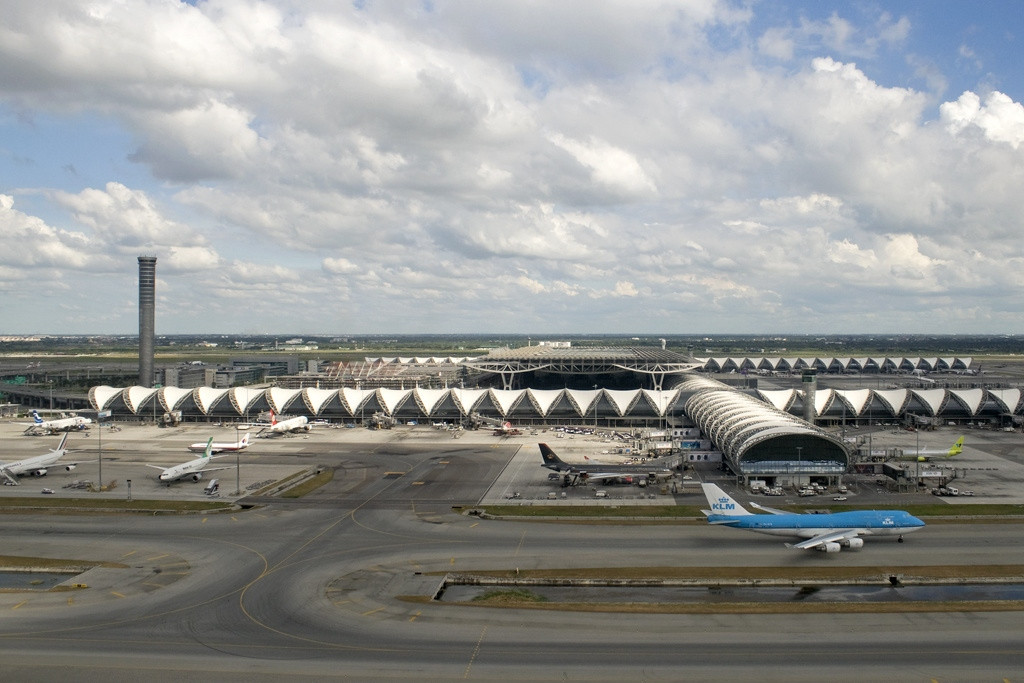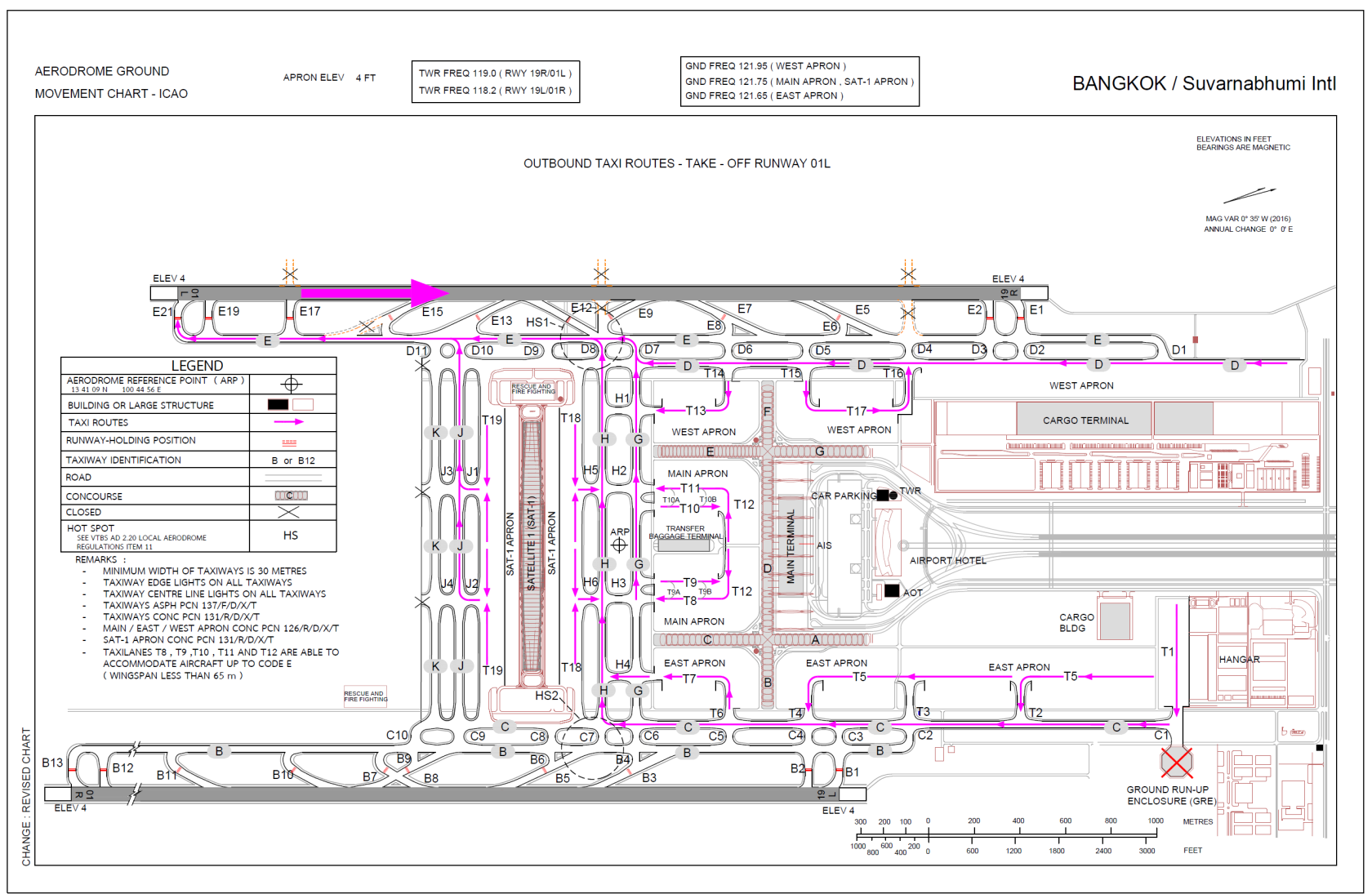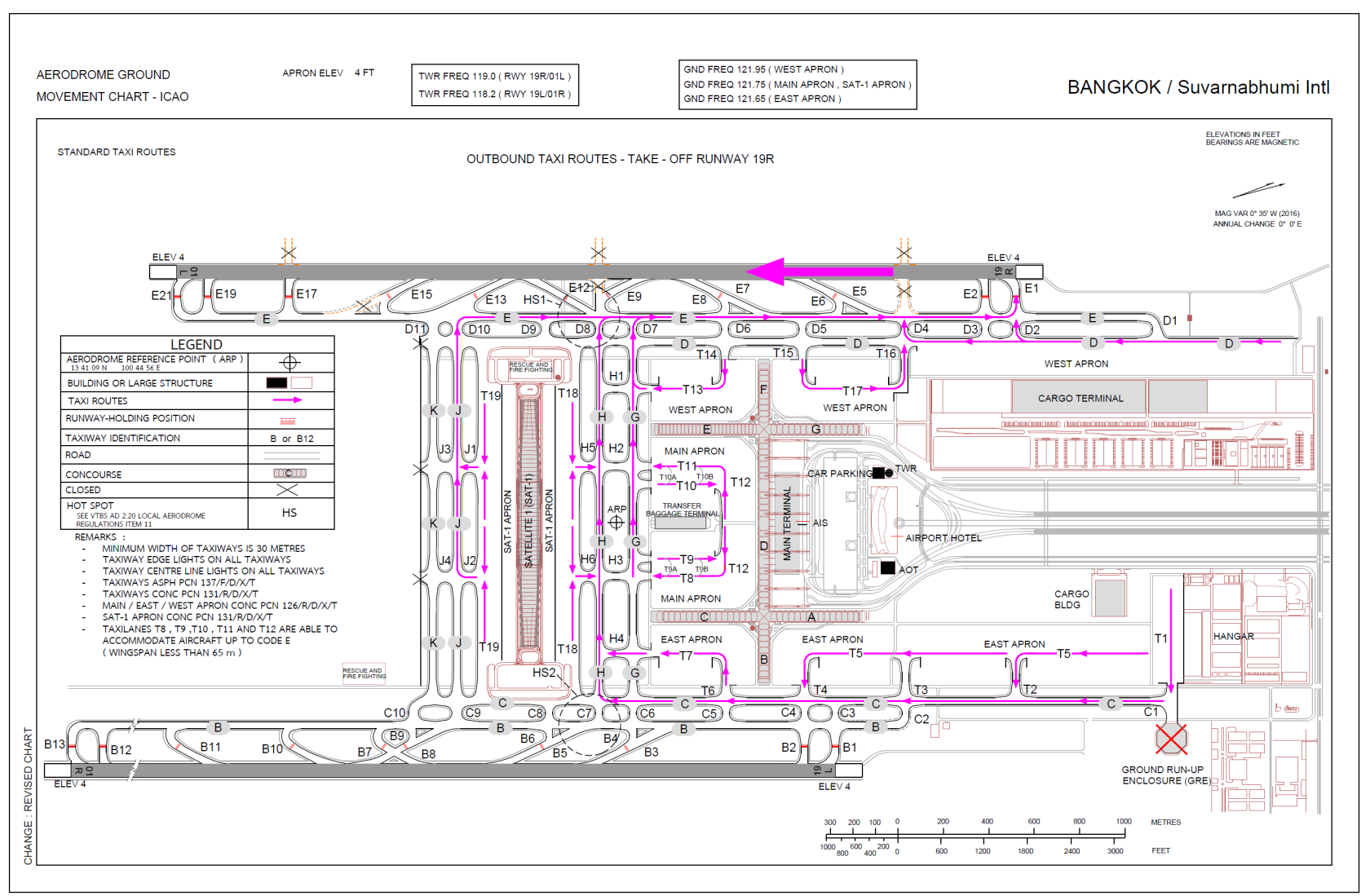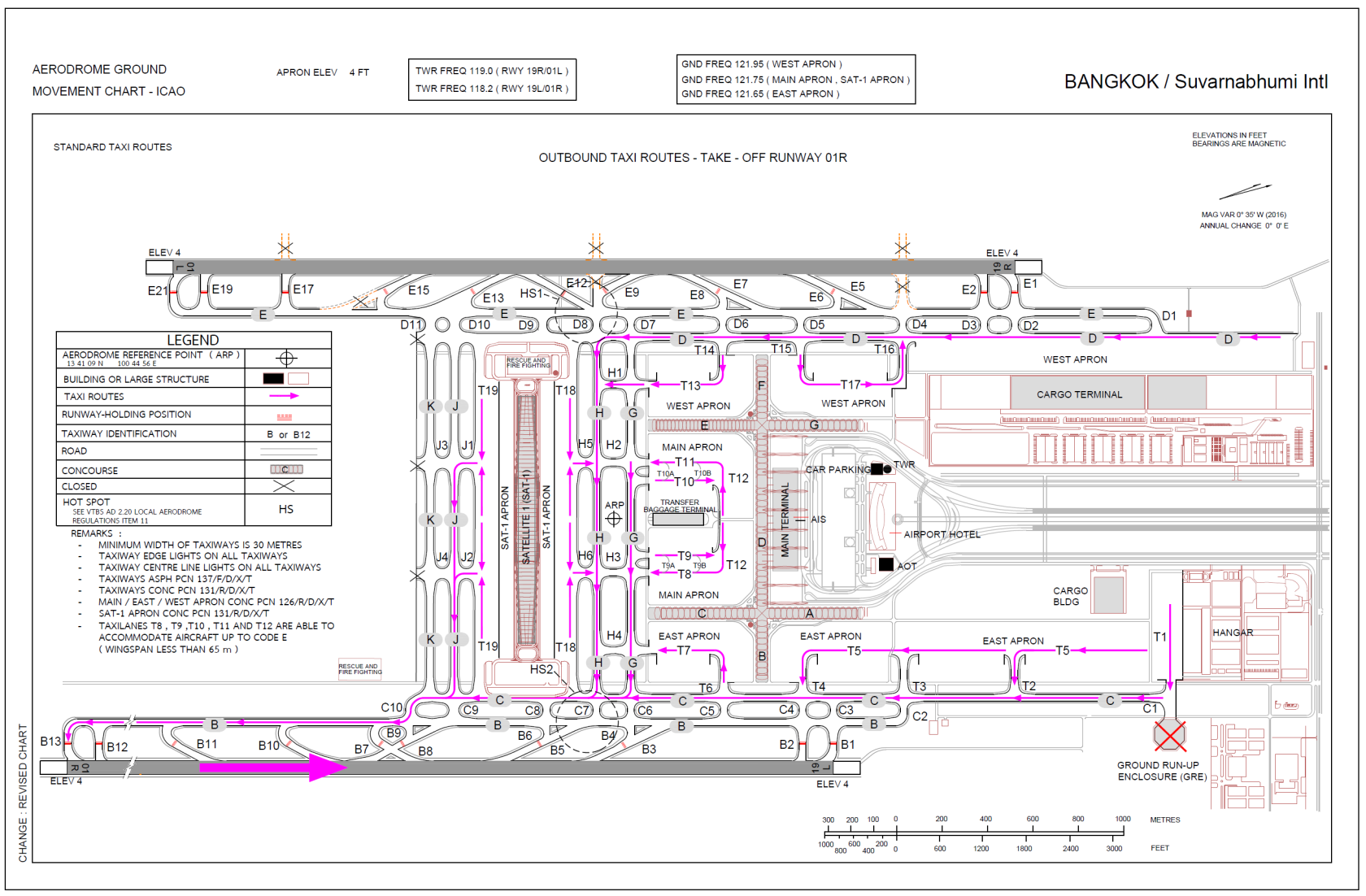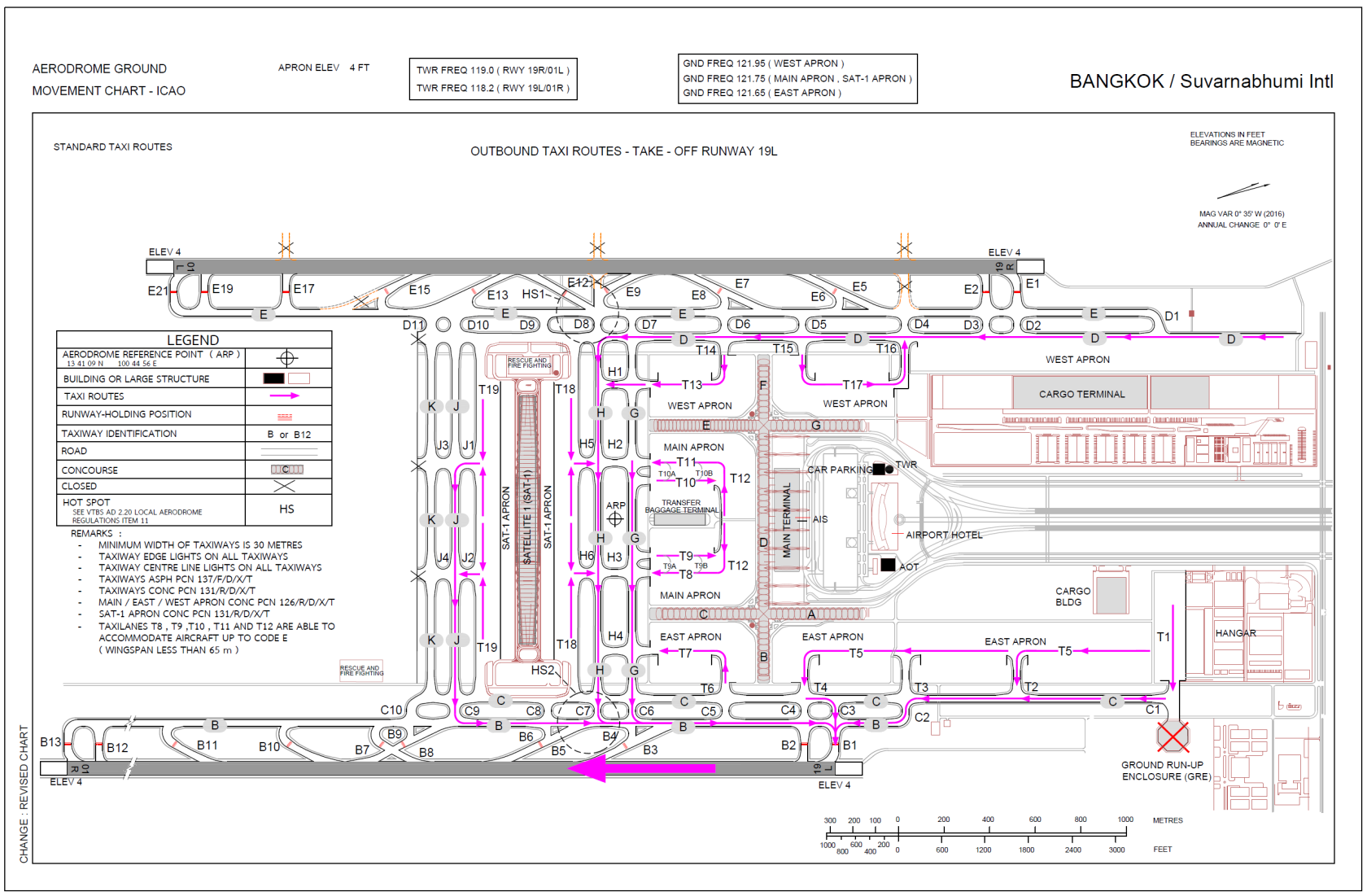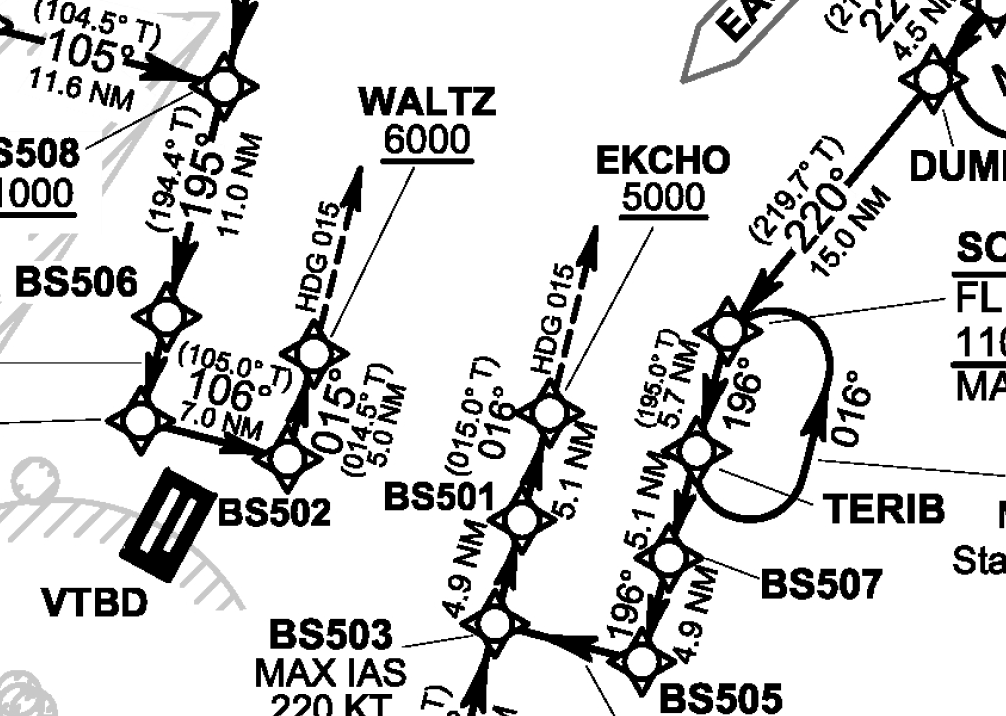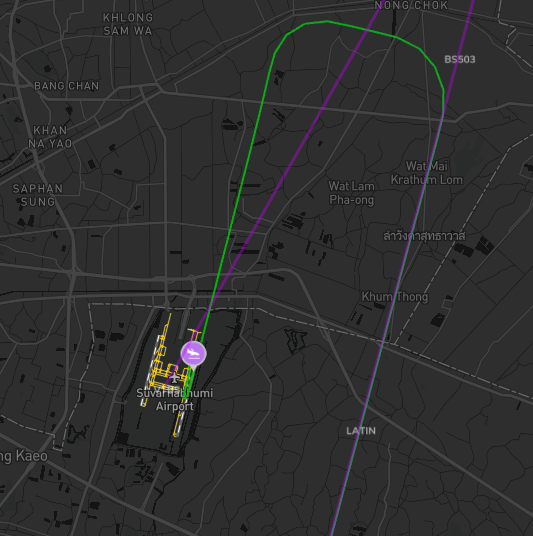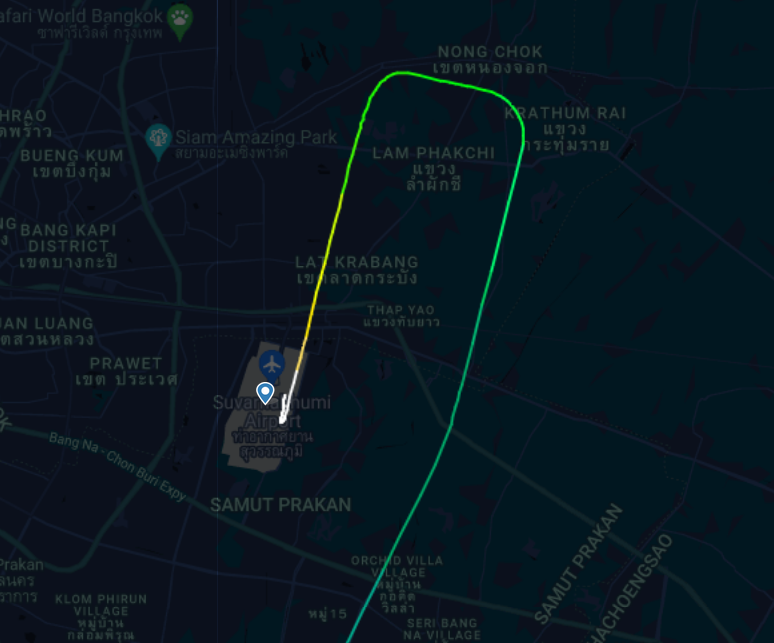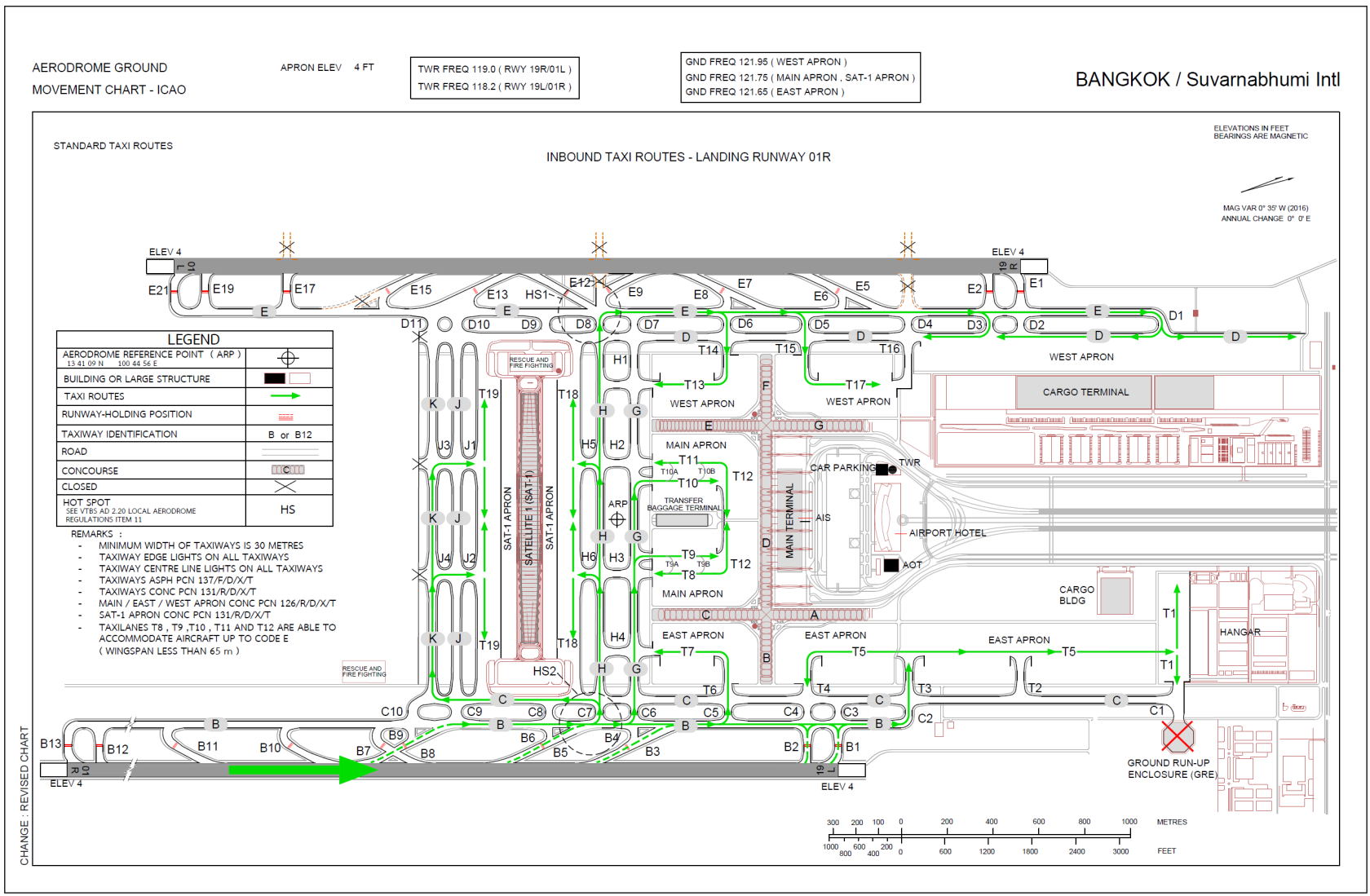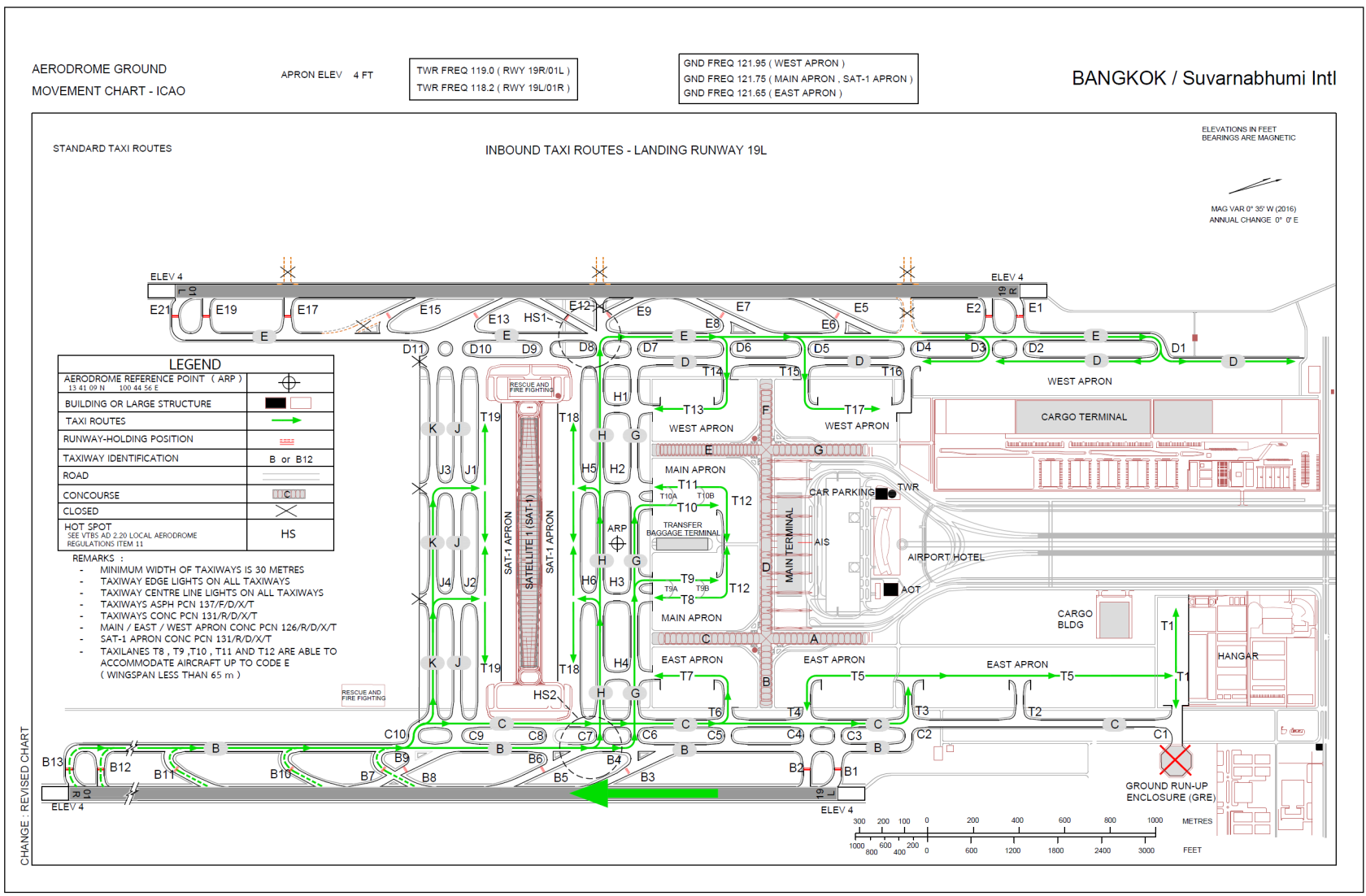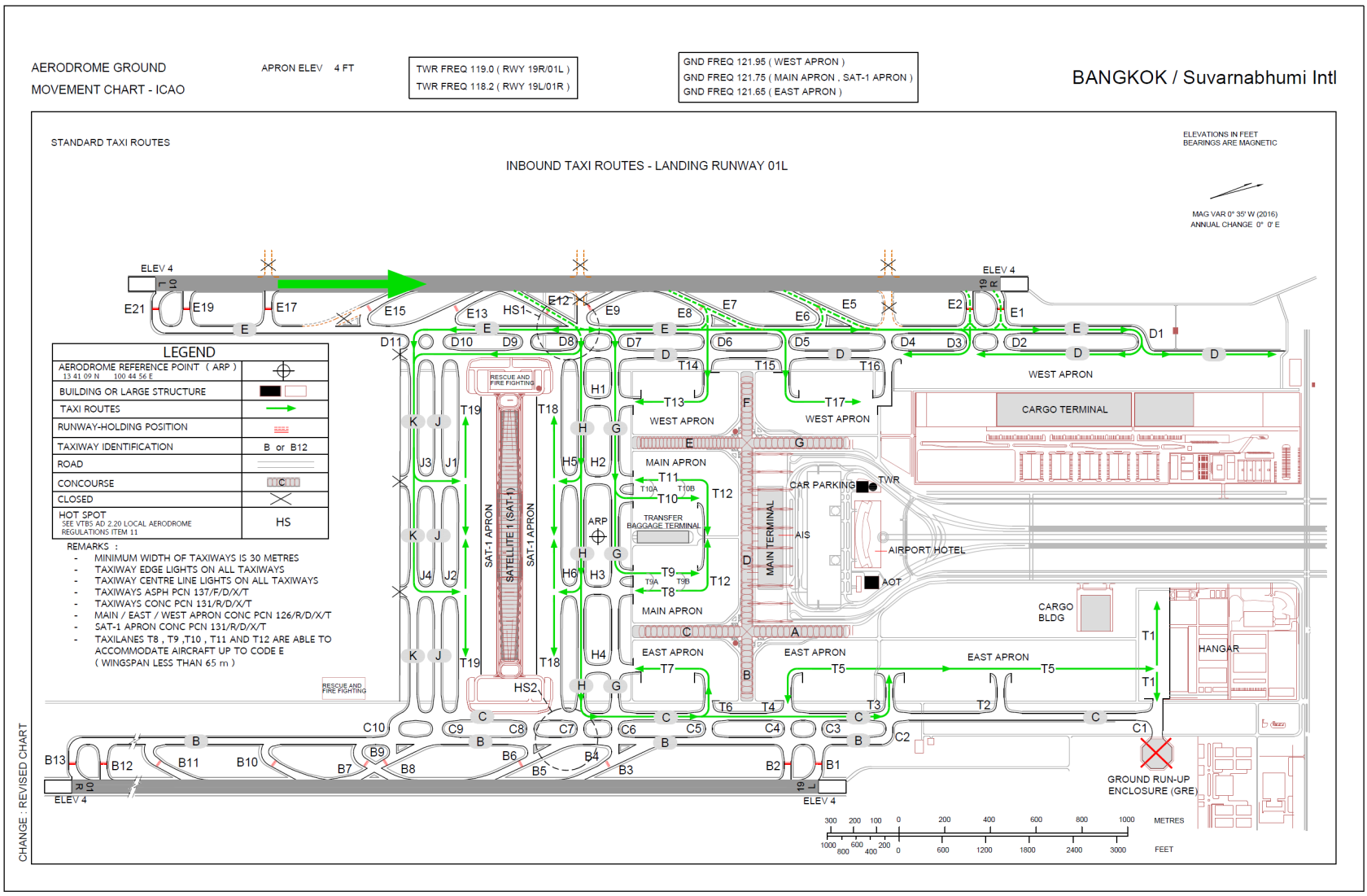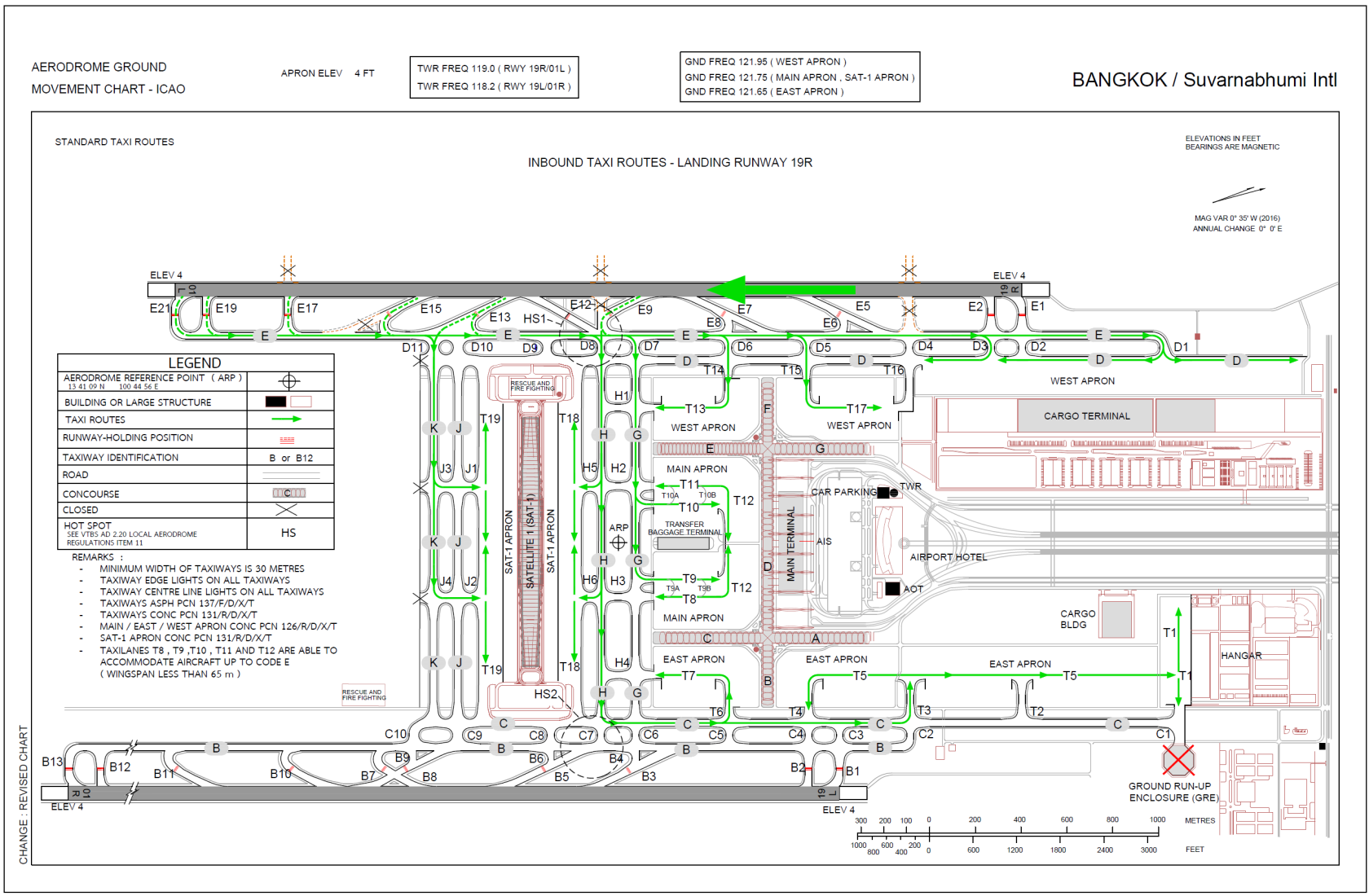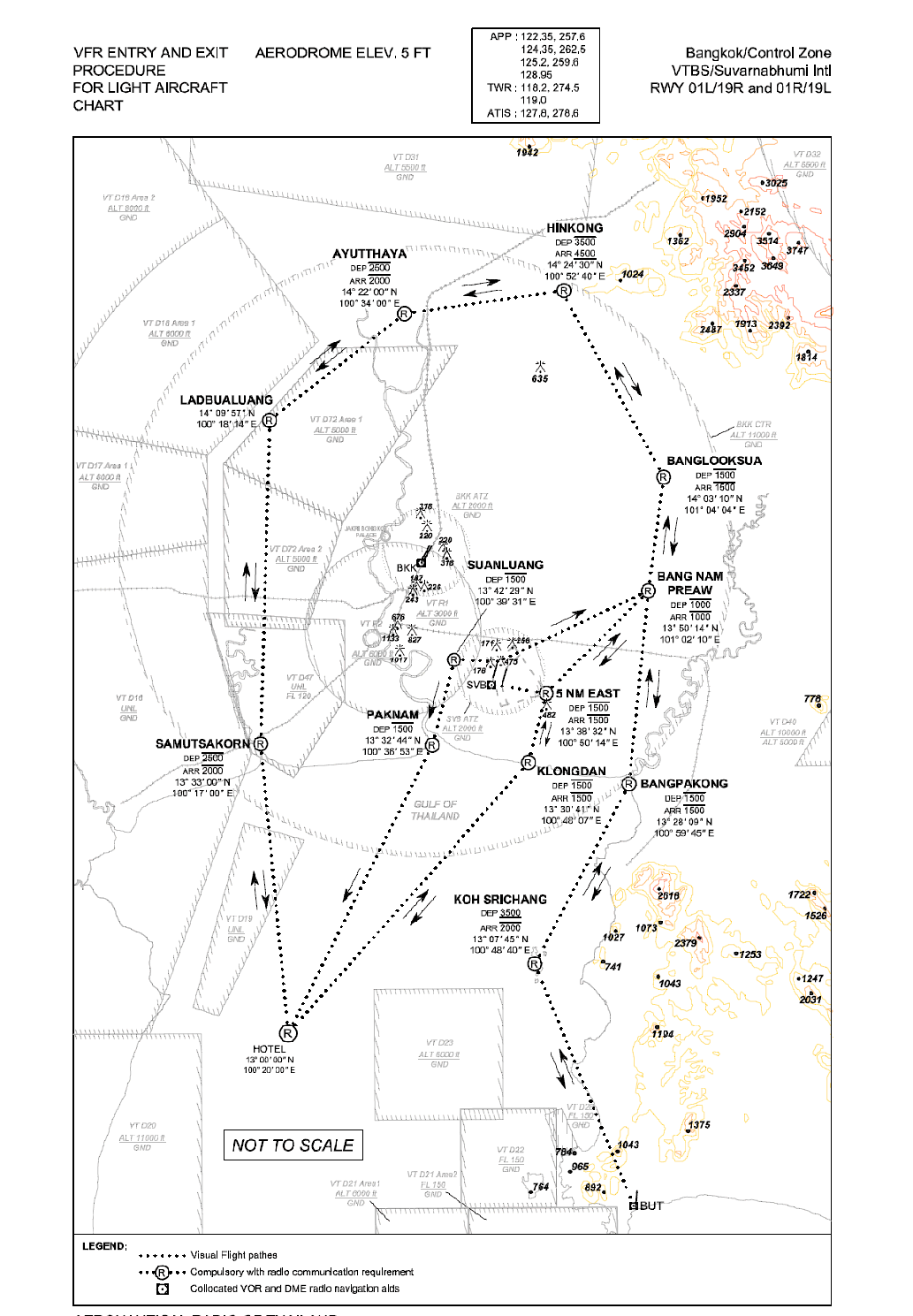VTBS - Suvarnabhumi Airport
Overview
Suvarnabhumi Airport (VTBS) is the biggest airport in Thailand, and is one of two airports covering Bangkok and the surrounding areas - the other being Don Mueang Airport (VTBD). Opened in 2006, it is located 25 kilometers east of downtown Bangkok and is a major hub for international transportation within Southeast Asia and beyond.
ATC frequencies
| Identifier | Radio Callsign |
Frequency | Remarks |
| VTBS_DEL | Suvarnabhumi Delivery |
128.700 MHz |
|
| VTBS_GND |
Suvarnabhumi Ground |
121.750 MHz | |
| VTBS_W_GND |
Suvarnabhumi Ground |
121.950 MHz |
Covering west apron |
| VTBS_E_GND |
Suvarnabhumi Ground |
121.650 MHz |
Covering east apron |
| VTBS_TWR | Suvarnabhumi Tower |
118.200 MHz |
|
| VTBS_W_TWR |
Suvarnabhumi Tower | 119.000 MHz |
Covering 19R/01L |
| VTBS_APP |
Bangkok Approach |
124.350 MHz | |
| VTBS_F_APP |
Suvarnabhumi Arrival |
121.100 MHz |
Arrivals below 7000ft |
| VTBS_DEP |
Suvarnabhumi Departure |
119.250 MHz | |
| VTBS_ATIS | - | 127.650 MHz |
Gates
At Suvarnabhumi, there are two areas in use: the main terminal (A-G gates), and the newly opened SAT-1 terminal.
Domestic flights
- A Gates
- B Gates
- Remote stands (including stands in front of cargo terminal)
International flights
- C Gates
- D Gates
- E Gates
- F Gates
- G Gates
- SAT-1 Terminal
- Remote stands (including stands in front of cargo terminal)
Cargo flights
- Remote stands in front of cargo terminal (506-525)
Preferential runway system
The runway in use on VATSIM does not necessarily follow what is used in real life all the time for various reasons, including but not limited to traffic, controller discretion, etc.
Generally, runway 19L/R is used unless the tailwind component exceeds 5 knots (usually in the winter season).
The runway on the left side (01L or 19L) are generally used for landings, while the right side (01R or 19R) is used for departures.
Transition Altitude & Transition Level
For all airports in Thailand, the transition altitude is 11,000ft and the transition level is always FL130.
Departing flights
IFR Clearance
On initial contact, state stand number and received ATIS.
| 👨✈️ | Suvarnabhumi Delivery, sawasdee krub, THAI 104, information B, gate A4, requesting IFR clearance to Chiang Mai |
| 🎧 | THAI 104, Delivery, sawasdee krub, cleared to Chiang Mai via flight planned route, TANGO3G departure, runway 19R, initial climb 6000ft, expect FL360, squawk 7120 |
The standard initial climb altitude for all departures is 6,000ft.
Pushback
Pushback instructions will include the direction for the nose to face.
| 👨✈️ | Suvarnabhumi Ground, sawasdee krub, THAI 104, gate A4, requesting push and start |
| 🎧 | THAI 104, Suvarnabhumi Ground, sawasdee krub, push and start approved, facing south on T5 |
If the pushback is not approved straight away, a reason will be given by the controller.
Taxi
Please take a look at the ground charts at least once before requesting taxi. The taxiway layout is quite complex with different taxiway designations for each intersection.
StandardPublished charts have common taxi routes are available and usually used by ATC (subject to discretion).
Departures - RWY 01L/19R
Charts are from AIP Thailand effective date 16 MAY 2024 and are for reference only.
To access the latest charts, click here
Departures - RWY 01R/19L
Charts are from AIP Thailand effective date 16 MAY 2024 and are for reference only.
To access the latest charts, click here
Departure
All speed and level restrictions apply unless explicitly cancelled by ATC!
Upon first contact with the departure frequency, state your altitude passing and assigned SID.
| 👨✈️ | Suvarnabhumi Departure, Thai 104, passing 1300ft for 6000ft, TANGO3G departure |
You will be identified and given further climb instructions when appropriate. Do not climb above initial climb altitude (usually 6,000ft) until assigned otherwise.
As alluded above, there are restrictions on the SID which need to be followed unless cancelled. Keep an ear out for the following phraseology:
| 🎧 |
THAI 104, climb unrestricted FL160 THAI 104, climb via SID FL160, no restrictions All speed and level restrictions on the SID are cancelled. You still have to maintain 250kts or less below 10,000ft |
| 🎧 |
THAI 104, climb via SID FL160, cancel level / altitude restrictions Only level restrictions on the SID are cancelled, speed restrictions remain |
| 🎧 |
THAI 104, climb via SID FL160, cancel speed restrictions Only speed restrictions on the SID are cancelled, level restrictions remain. 250 kts or less below 10,000ft still applies |
| 🎧 |
THAI 104, direct TANGO All restrictions for waypoints before TANGO are cancelled. You still have to maintain 250kts or less below 10,000ft |
Subsequently, when nearing FL160, you will be handed off to enroute ATC (Bangkok Control) if online.
Arriving flights
During cruise, you will be cleared for an appropriate STAR for the active runway(s). When nearing top of descent, inform the controller that you are ready for descent if instructions have not yet been given.
When nearing FL180, you will be handed off to Bangkok Approach if online.
Descent
All STARs have speed and level restrictions. You must follow them unless explicitly cancelled by ATC, or if instructions were given at a time where it is impractical to meet those restrictions.
| 🎧 |
THAI 103, descend via STAR 5000ft QNH 1013, no restrictions All speed and level restrictions on the STAR are cancelled. You still have to maintain 250kts or less below 10,000ft |
| 🎧 |
THAI 103, descend via STAR 5000ft QNH 1013, cancel level / altitude restrictions Only level restrictions on the STAR are cancelled, speed restrictions remain |
| 🎧 |
THAI 103, descend via STAR 5000ft QNH 1013, cancel speed restrictions Only speed restrictions on the STAR are cancelled, level restrictions remain. 250 kts or less below 10,000ft still applies |
| 🎧 |
THAI 103, direct EKCHO All restrictions for waypoints before EKCHO are cancelled. You still have to maintain 250kts or less below 10,000ft |
If traffic levels are low, you may be given "direct to" instructions to shorten the track miles to landing, or told by ATC to expect shortcuts. In that case, you can use your discretion to descend below VNAV profile while following constraints if not cancelled.
Open STARs
All VTBS STARs are open STARs. If ATC has not given instructions otherwise, continue on the charted heading after the last waypoint on the STAR. Do not proceed on instrument approach procedure without ATC clearance!
Approach clearance
There are two methods that you can be cleared for the ILS or LOC Z approach:
You may be cleared for the approach even though you are still on the downwind leg.
| Runway |
19L |
19R |
01L |
01R |
| Waypoints (ILS Z) |
LANCO @ 2500ft LINSY @ 3500ft LEMOS @ 5000ft |
ROMME @ 2500ft RYAUN @ 3500ft REWCO @ 5000ft |
LONNY @ 2500ft LACOS @ 3000ft
|
RAYPA @ 2500ft RISSE @ 3000ft |
This can happen from three situations:
- Turn after waypoint: "After BS503, direct LANCO"
- The intended turn is 90 degrees. You do not need to wait until you have reached BS503 before starting the turn, it is not abeam.
- This can be programmed in the flight management computer in your aircraft.
Examples of correct execution
In this specific example the turn is programmed using the A320 MCDU.
Real life example from Flightradar24 (BS503 -> LANCO)
- Straightforward turn: "Turn left direct LANCO"
- "Resume own navigation" after vectoring: "Resume own navigation, direct LANCO"
After you are given the approach clearance, you may descend below your last assigned altitude in accordance to the procedure.
| 🎧 |
THAIVIETJET 2343, cleared ILS Z approach runway 19L, report established |
2) Vectoring to intercept localizer
In this case, you will be given heading and altitude instructions, ending with a clearance to intercept the localizer (and glideslope if ILS). Inform the controller once you are established on the approach.
Speed control
To facilitate traffic flow, ATC may issue speed instructions such as follows:
| 🎧 |
THAIVIETJET 2343, speed 160 knots or greater until 6 miles final |
The ILS DME for Suvarnabhumi is offset by 2.2nm (01L/19R) or 2.3nm (01R/19L) - in other words, at the runway threshold, the DME will read 2.2 or 2.3nm.
As such, you should rely on the navigation display or apply the offset if relying on the DME.
Landing
On first contact with Tower, state your callsign and arriving runway. You will be given the weather information, and if there is no preceding traffic for the runway, you will be cleared to land.
As of writing, there is only one side to vacate for each runway. Expect simple taxi instructions on rollout.
Please ensure you vacate the runway completely. Additionally, with instructions, please turn onto the assigned taxiway without stopping at the runway exit.
If you have a particular stand in mind, please inform Ground on initial contact.
Taxi
Please take a look at the ground charts at least once before arrival. The taxiway layout is quite complex with different taxiway designations for each intersection.
Standard taxi routes are available and usually used by ATC (subject to discretion).
Arrivals - RWY 01R/19L
Charts are from AIP Thailand effective date 16 MAY 2024 and are for reference only.
To access the latest charts, click here
Arrivals - RWY 01L/19R
Charts are from AIP Thailand effective date 16 MAY 2024 and are for reference only.
To access the latest charts, click here
VFR flights
While VFR traffic is not present at Suvarnabhumi in real life, there exists procedures and reporting points.
Controlled airspace
- Suvarnabhumi Aerodrome Traffic Zone - a circle of 5nm radius around VTBS, SFC-2,000ft
- Bangkok Control Zone - a circle of 35nm radius around VTBD, SFC-11,000ft
- Bangkok Terminal Control Area - a circle of 50nm radius around VTBD, 3,000ft-FL160
Reporting points
Usually aircraft departing west will be asked to report over Suanluang, while aircraft departing east will be asked to report over 5NM East.
ATC clearance
Initial contact will be with Ground (or higher station covering). Delivery does not cover VFR traffic; request VFR clearance from Ground.
Closing remarks
If you do not understand any instructions on frequency, please do not hesitate to ask for clarification! Our controllers are here to assist you.
Any constructive feedback (no matter positive or negative) for our controllers can be submitted at this page.
Thank you for reading this pilot briefing and we sincerely hope you enjoy your flight to/from Suvarnabhumi Airport!
